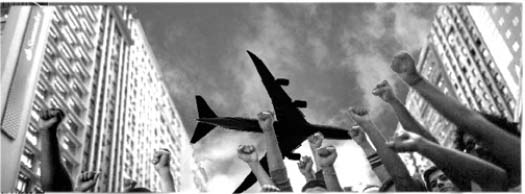LOS ANGELES WINS LAWSUIT AGAINST THE FEDERAL AVIATION ADMINISTRATION
- Details
- Category: Community News
- Published on Wednesday, 15 September 2021 00:23
- Written by Dianne V. Lawrence

Since it began over four years ago, TNN has been reporting on the nightmare, one lane, air traffic highway called Nextgen which has been flying over residents in Malibu, Santa Monica, Culver City, West Adams and around downtown LA.
These communities woke up to planes flying at low altitudes, single file above their homes every 4 – 5 minutes at its worst, and into the night. The planes coming from the east (Asia, Hawaii) and the north cannot fly directly into the airport from the Santa Monica Bay. They have to fly over LA, turn around downtown and join the landing flights arriving from the east and headed west to the airport. They used to fly in from multiple air paths and at higher altitudes before turning and joining. In anticipation of increased air traffic, the FAA's program Nextgen changed all that by creating one easier-to-manage path and placing the flights at lower altitudes so they could turn sooner to join the lower altitudes of the incoming flights closer to the airport.
Nextgen was rolled out across America to meet the needs of the endlessly growing air traffic and the airlines' bottom line. The only problem is that as the sky becomes more populated with a variety of flying vehicles - increased flights, air taxis, drones, news and taxi helicopters - the laws regulating them do not take into account the noise and air pollution affecting people on the ground. It’s a separate world above with its own laws and only token but toothless accountability to the world on the ground.

Residents rallied and started petitioning their representatives. There was a Quiet Skies Caucus formed by congressional house representatives who challenged the FAA when they came to Congress to get funding. Karen Bass who represents our district, was an early member and fighter against Nextgen. Local residents formed groups like the Sky Justice National Network Facebook page where people from all over the country share information and support. Quiet Skies LA, made up of members from Culver City and West Adams created a 1,000 signature petition sent to local representatives. They also organized a protest at the mayors residence. The mayor met with them and provided support for an alternative path map they had created. The LAX Roundtable (the airport organization that mediates between affected communities and the airport over noise issues) assisted in the presention to the Roundtable who recently approved sending the map to the FAA for consideration. Culver City filed a lawsuit but lost their case. Councilman Wesson assigned a deputy, Jeff Camp, to the issue and his office along with other affected councilmembers began writing letters to the FAA which were ignored. When that failed, they took it to the next level and worked behind the scenes to support a lawsuit by the City Attorney. Finally, a window opened that allowed the Los Angeles City Attorney to step in and sue the FAA and after nearly two years of back and forth in the courts, the city won.
Statement from the City Attorney's Office JULY 8
The Ninth Circuit issued an opinion which invalidates the Federal Aviation Administration’s (FAA) changes to flight procedures for aircraft arriving at Los Angeles International Airport. The court agreed with the City of Los Angeles that FAA violated the National Environmental Policy Act, National Historic Preservation Act, and Section 4(f) of the Department of Transportation Act by failing to conduct an environmental review and to consult with the City before making the flight procedure changes. The court found that FAA’s after-the-fact analysis of environmental impacts did not comply with the law and that the agency improperly applied its procedures for so-called categorical exclusions which would have allowed only minimal environmental review. The court's ruling does allow the existing FAA flight procedure to remain in place while FAA conducts a proper environmental review, which under federal law will include public comment and consultation with the City. The Ninth Circuit did not rule on the City's secondary petition to invalidate an FAA notice regarding its website, holding that it was not a final agency action upon which it could rule.
Statement from the City Attorney's Office JULY 8
The Ninth Circuit issued an opinion which invalidates the Federal Aviation Administration’s (FAA) changes to flight procedures for aircraft arriving at Los Angeles International Airport. The court agreed with the City of Los Angeles that FAA violated the National Environmental Policy Act, National Historic Preservation Act, and Section 4(f) of the Department of Transportation Act by failing to conduct an environmental review and to consult with the City before making the flight procedure changes. The court found that FAA’s after-the-fact analysis of environmental impacts did not comply with the law and that the agency improperly applied its procedures for so-called categorical exclusions which would have allowed only minimal environmental review. The court's ruling does allow the existing FAA flight procedure to remain in place while FAA conducts a proper environmental review, which under federal law will include public comment and consultation with the City. The Ninth Circuit did not rule on the City's secondary petition to invalidate an FAA notice regarding its website, holding that it was not a final agency action upon which it could rule.
News Category
-
Community News
Read This Before Voting for Heather Hutt
 CD10 OVERVIEW - The lurid tale of politics as usual in CD10.
Los Angeles has consistently been cited...
CD10 OVERVIEW - The lurid tale of politics as usual in CD10.
Los Angeles has consistently been cited...
-
Neighborhood Councils
NEIGHBORHOOD COUNCIL UPDATE
Local Neighborhood Councils are a proactive way to become involved in your relationship with the...
-
City News
Communities Preparing for Disaster
 by Bob Gelfand CitywatchLAGELFAND’S WORLD - In a week of sometimes depressing news, I would like...
by Bob Gelfand CitywatchLAGELFAND’S WORLD - In a week of sometimes depressing news, I would like...
-
Crime Reports
HOW TO TELL IF YOU ARE THE TARGET OF A PHONE SCAM
 Every year, thousands of people lose money to telephone scams — from a few dollars to their life...
Every year, thousands of people lose money to telephone scams — from a few dollars to their life...
-
Local Development
WHAT IS DESTINATION: PICO AND WHY IS IT DOING ALL THOSE NICE THINGS ON PICO?
 Destination: Pico is a community nonprofit working to make Pico Boulevard more walkable, vibrant,...
Destination: Pico is a community nonprofit working to make Pico Boulevard more walkable, vibrant,...
Today8
Yesterday10
Week45
Month245
All964859
Kubik-Rubik Joomla! Extensions
Yesterday10
Week45
Month245
All964859
Currently are 19 guests and no members online
Kubik-Rubik Joomla! Extensions



